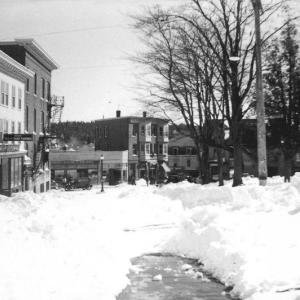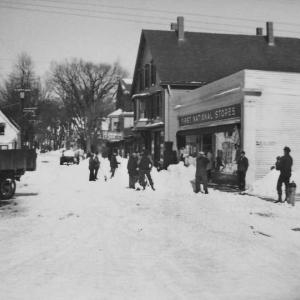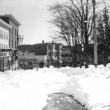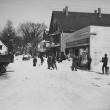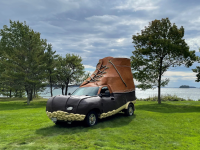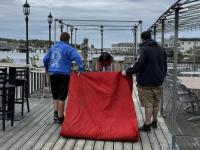The blizzard of February 1952
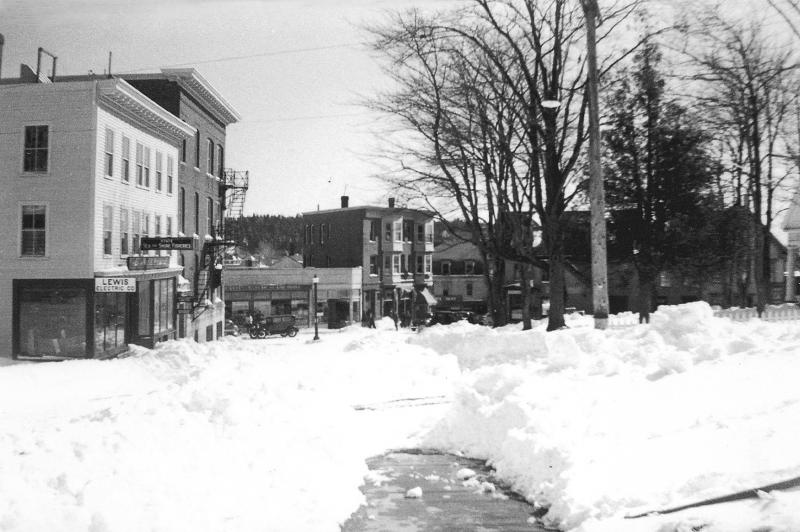 This view of the south ends of Oak Street and Townsend Avenue dates to the aftermath of the mid-February 1952 blizzard. The bank building on the left still is at its original height. Directly down on Townsend, next to the Paine Block, is the old Crockett's "5 & 10," which fit my allowance just fine in the 1950s. Just a corner of the library shows on the right. Courtesy of the Boothbay Region Historical Society
This view of the south ends of Oak Street and Townsend Avenue dates to the aftermath of the mid-February 1952 blizzard. The bank building on the left still is at its original height. Directly down on Townsend, next to the Paine Block, is the old Crockett's "5 & 10," which fit my allowance just fine in the 1950s. Just a corner of the library shows on the right. Courtesy of the Boothbay Region Historical Society
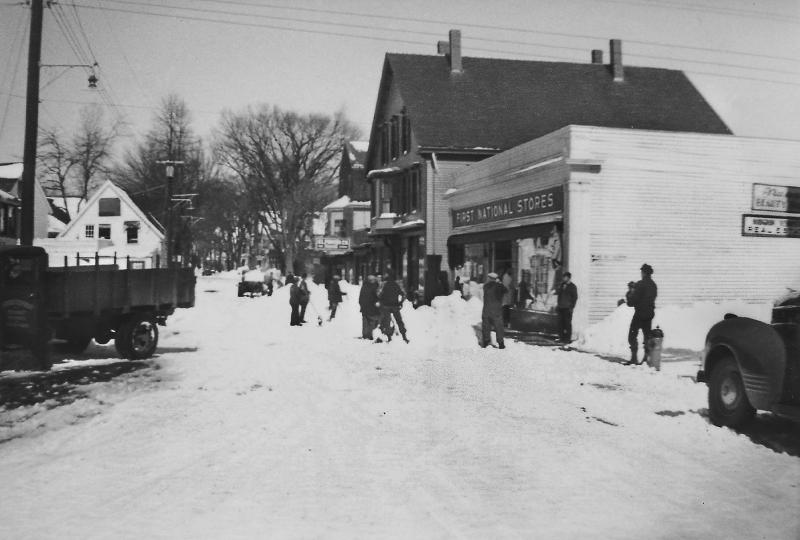 Teams of shovelers work on the February 1952 snow piles on Townsend Avenue. The First National was one of the two chain grocery stores in the Harbor's downtown; the other was the A&P on the site of Sherman's. The “National” site later became Bob's Photo-TV, and is now a popcorn store. The malling of the Meadow ended downtown chain groceries. Courtesy of the Boothbay Region Historical Society
Teams of shovelers work on the February 1952 snow piles on Townsend Avenue. The First National was one of the two chain grocery stores in the Harbor's downtown; the other was the A&P on the site of Sherman's. The “National” site later became Bob's Photo-TV, and is now a popcorn store. The malling of the Meadow ended downtown chain groceries. Courtesy of the Boothbay Region Historical Society
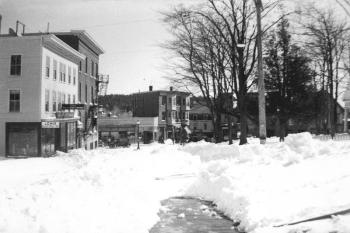 This view of the south ends of Oak Street and Townsend Avenue dates to the aftermath of the mid-February 1952 blizzard. The bank building on the left still is at its original height. Directly down on Townsend, next to the Paine Block, is the old Crockett's "5 & 10," which fit my allowance just fine in the 1950s. Just a corner of the library shows on the right. Courtesy of the Boothbay Region Historical Society
This view of the south ends of Oak Street and Townsend Avenue dates to the aftermath of the mid-February 1952 blizzard. The bank building on the left still is at its original height. Directly down on Townsend, next to the Paine Block, is the old Crockett's "5 & 10," which fit my allowance just fine in the 1950s. Just a corner of the library shows on the right. Courtesy of the Boothbay Region Historical Society
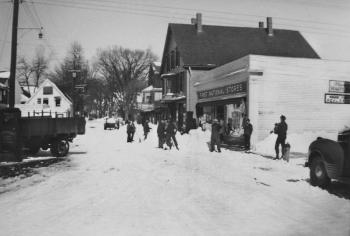 Teams of shovelers work on the February 1952 snow piles on Townsend Avenue. The First National was one of the two chain grocery stores in the Harbor's downtown; the other was the A&P on the site of Sherman's. The “National” site later became Bob's Photo-TV, and is now a popcorn store. The malling of the Meadow ended downtown chain groceries. Courtesy of the Boothbay Region Historical Society
Teams of shovelers work on the February 1952 snow piles on Townsend Avenue. The First National was one of the two chain grocery stores in the Harbor's downtown; the other was the A&P on the site of Sherman's. The “National” site later became Bob's Photo-TV, and is now a popcorn store. The malling of the Meadow ended downtown chain groceries. Courtesy of the Boothbay Region Historical Society
There seems to be no letup on snowstorms this winter so I'm writing my third article on past region snowstorms: 1929, 1944 and now 1952. This year's storms are named A-Z, Atlas to Zephyr. As of February 21, we're up to Seneca, the 19th storm. Seven more to go to get to Zephyr!
The February 17-18 storm of 1952 started at 6 a.m. Sunday morning and lasted until 4 p.m. Monday. It affected the whole state and was the third worst in Portland's history. The February 22 Register article began its article on the storm, "A great swirling mass of snow roared down on this part of New England for a good 34 hours, leaving in its wake huge drifts, choked highways, and whole communities marooned."
The winds were gale force, sustained at 45 mph and gusting to 65 mph, so the depth in the region was difficult to measure; some places were bare of snow, while some drifts piled as high as 12 feet. The National Weather Service declared about 21 inches fell in 24 hours and 30 inches altogether for both days. "Blinding," was the preferred word for the whipped walls of driving snow.
There were minor food and fuel shortages here, but no real catastrophes. There was a run on yeast cakes with all store bread long gone, and milk deliveries vanished for a few days. Once milk runs were restored, the milkmen made arctic treks to reach some of the houses. No mail came or went until the Coast Guard took it by water late Tuesday and brought back the incoming. The Damariscove Coast Guard Station reported very high seas, with some skippers reporting 60-foot waves.
Boothbay conditions
The Boothbay stretch of Route 27 was blocked in three places, and old hands at local winter driving can predict those locations, all near what once were or still are open fields. One was at Spinney's field, developed into Chapel Street at Boothbay Center in the 1950s; the second was near the present Railway Village, near Lew Perkins' dairy fields; the third was at Happy Hollow near the Edgecomb line.
The Boothbay town trucks broke down. The town manager said Lermond Giles and Willard Adams "saved the day" by plowing the town with their trucks. Lermond had been one of Boothbay's three road commissioners from 1937 to 1947, while Willard had been one from 1934 to 1947. Lermond had two four-wheel-drive Army trucks, and Willard had one four-wheel-drive truck with the only V plow in the region. All three trucks carried teams of shovelers in the back and did "yeoman's service clearing Boothbay roads." By Thursday, all of Boothbay's inhabited roads were clear, while the uninhabited ones were yet to get attention.
Two East Boothbay shipyards, Hodgdon Brothers and Goudy & Stevens, had combined to get bonded for Navy work during World War II and the Korean War (1950-1953). On Tuesday, Feb. 19, 1952, only one-third of the 240 men working at those yards made it in, probably those who lived within walking distance. I imagine they spent much of the day shoveling — all minesweepers were built outside. The workforce there nearly doubled to 400 within a few months.
In the Harbor
The Harbor plows could only manage a narrow cow path down Townsend Avenue. People walked there in the street if necessary, since driving was out of the question. The Register reported, "In many places the snow was so deep and solidly packed that the big plows and heavy trucks simply bounced off." The Harbor's trucks broke as well, one breaking two axles, but another was repaired quickly. Clearing Atlantic Avenue required a loader to take bites out of the drifts. An all-out effort taking many hours and men opened up Spruce Point when it was learned someone there needed a doctor.
The center of town had towering piles of snow left by plows and teams of high school students, who were enlisted to shovel during school vacation week. Farther out, roads, such as those at Oak Point, were finally opened late Wednesday. Modern powerful trucks would have helped, but the wind in any decade can still refill in minutes what's just been cleared.
Event Date
Address
United States

